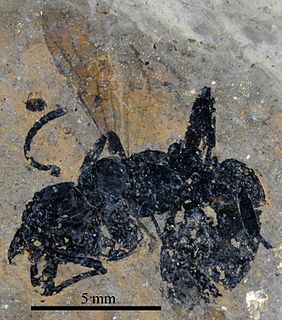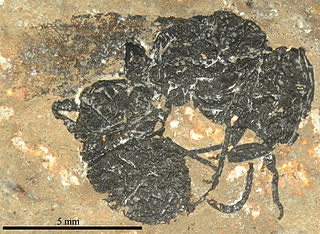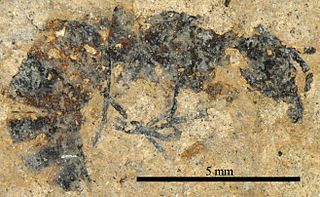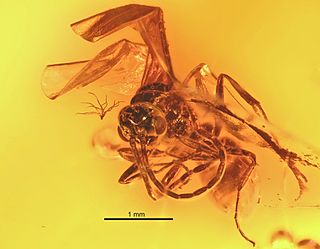
Prionomyrmex is an extinct genus of bulldog ants in the subfamily Myrmeciinae of the family Formicidae. It was first described by Gustav Mayr in 1868, after he collected a holotype worker of P. longiceps in Baltic amber. Three species are currently described, characterised by their long mandibles, slender bodies and large size. These ants are known from the Eocene and Late Oligocene, with fossil specimens only found around Europe. It is suggested that these ants preferred to live in jungles, with one species assumed to be an arboreal nesting species. These ants had a powerful stinger that was used to subdue prey. In 2000, it was suggested by Cesare Baroni Urbani that the living species Nothomyrmecia macrops and a species he described both belonged to Prionomyrmex, but this proposal has not been widely accepted by the entomological community. Instead, scientists still classify the two genera distinctive from each other, making Nothomyrmecia a valid genus.

Pachycondyla eocenica is an extinct species of ant in the formicid subfamily Ponerinae described from fossils found in Europe. P. eocenica is one of six Lutetian Pachycondyla species.

Pachycondyla lutzi is an extinct species of ant in the formicid subfamily Ponerinae described by from fossils found in Europe. P. lutzi is one of six Lutetian Pachycondyla species.

Pachycondyla? messeliana is an extinct species of ants in the formicid subfamily Ponerinae described by from a fossil found in Europe. P.? messeliana is one of six Lutetian Pachycondyla species.

Pachycondyla parvula is an extinct species of ant in the formicid subfamily Ponerinae described by from a fossil found in Europe. P. parvula is one of six Lutetian Pachycondyla species.

Pachycondyla petiolosa is an extinct species of ant in the formicid subfamily Ponerinae described by from a fossil found in Europe. P. parvula is one of six Lutetian Pachycondyla species.

Pachycondyla petrosa is an extinct species of ant in the formicid subfamily Ponerinae described from a fossil found in Europe. P. petrosa is one of six Lutetian Pachycondyla species.

Paraneuretus is an extinct genus of formicid in the ant subfamily Aneuretinae known from fossils found in Asia and Europe. The genus contains three middle to late Eocene age species, Paraneuretus dubovikoffi, Paraneuretus longicornis, and Paraneuretus tornquisti.
Dolichoderus pinguis is an extinct species of formicid in the ant subfamily Dolichoderinae known from a fossil found in Asia. The species is one of a number in the genus described from fossils.
Formica biamoensis is an extinct species of formicid in the ant subfamily Formicinae known from fossils found in eastern Asia.

Bradoponera is an extinct genus of ant in the Formicidae subfamily Proceratiinae, and is one of four genera of the subfamily. The genus contains four described species Bradoponera electrina, Bradoponera meieri, Bradoponera similis, and Bradoponera wunderlichi. The species are known from several Middle Eocene amber fossils which were found in Europe.
Formica paleosibirica is an extinct species of formicid in the ant subfamily Formicinae known from fossils found in eastern Asia.
Gesomyrmex magnus is an extinct species of formicid in the ant subfamily Formicinae known from a fossil found in eastern Asia.
Gesomyrmex incertus is an extinct species of formicid in the ant subfamily Formicinae known from a fossil found in eastern Asia.
Pachycondyla oligocenica is an extinct species of formicid in the ant subfamily Ponerinae known from a fossil found in eastern Asia.
Pachycondyla aberrans is an extinct species of formicid in the ant subfamily Ponerinae known from a single fossil found in Russia.
Proceratium petrosum is an extinct species of formicid in the ant subfamily Proceratiinae known from a fossil found in eastern Asia.
Agastomyrma is an extinct genus of formicid in the ant subfamily Myrmicinae known from the fossil species Agastomyrma laticeps found in eastern Asia.

Pachycondyla succinea is an extinct species of ant in the formicid subfamily Ponerinae described from fossils found in Europe. P. petrosa is one of three middle Eocene Pachycondyla species found in Baltic amber.

Nylanderia pygmaea is an extinct species of formicid in the ant subfamily Formicinae known from fossils found in the Baltic region.











